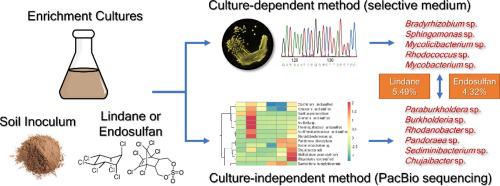Microbiological Research ( IF 6.1 ) Pub Date : 2021-07-13 , DOI: 10.1016/j.micres.2021.126817 Siang Chen Wu, Jian-Kai Gao, Bo-Sheng Chang

|
Bioremediation for lindane and endosulfan removal is a cost-effective approach, but its effectiveness depends on the ability to isolate degrading functionalized microorganisms. Researchers have isolated many lindane and endosulfan degrading bacteria from enrichment cultures based on culture-dependent methods during the past decades. However, it is unknown whether the isolated bacteria can reflect the indigenous predominant degraders in enriching cultures. In this study, we compared the culture-dependent method with selective medium isolation with culture-independent method (PacBio SMRT sequencing of full-length 16S rRNA amplicon) to analyze the bacterial communities from four distinct lindane (LA1 and LC1) and endosulfan (EA1 and EC1) enrichment cultures. From all the isolates we harvested from lindane (63 isolates) and endosulfan (61 isolates) enrichment cultures, their BLAST alignment can only match 5.49 % and 4.32 % of the bacterial operational taxonomic units (OTUs), respectively. Rhodanbacter lindaniclasticus and Pandoraea thiooxydans were the rarely seen potential degrading representatives that were simultaneously enriched and isolated. This study is the first comparative analysis of microbial communities from lindane and endosulfan enrichment culture using culture-dependent and culture-independent methods. Our results suggested that developing a target-specific and efficient microbial isolation method is necessary to harvest and study representative degrading bacteria in the community.
中文翻译:

使用依赖培养和独立方法分离林丹和硫丹降解细菌以及微生物群落中的优势分析
去除林丹和硫丹的生物修复是一种具有成本效益的方法,但其有效性取决于分离降解功能化微生物的能力。在过去的几十年里,研究人员基于依赖培养的方法从富集培养物中分离出了许多林丹和硫丹降解细菌。然而,尚不清楚分离出的细菌是否能反映富集培养物中的本土主要降解物。在本研究中,我们将选择性培养基分离依赖培养的方法与不依赖培养的方法(全长 16S rRNA 扩增子的 PacBio SMRT 测序)进行了比较,以分析来自四种不同林丹(LA1 和 LC1)和硫丹(EA1)的细菌群落和 EC1) 富集培养物。Rhodanbacter lindaniclastus和Pandoraea thiooxydans是罕见的潜在降解代表,它们同时被富集和分离。本研究是首次使用依赖培养和不依赖培养的方法对来自林丹和硫丹富集培养物的微生物群落进行比较分析。我们的结果表明,开发特定目标且有效的微生物分离方法对于收获和研究社区中具有代表性的降解细菌是必要的。











































 京公网安备 11010802027423号
京公网安备 11010802027423号